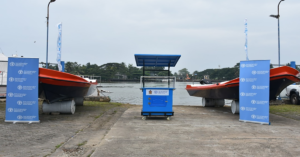Physical Address
23,24,25 & 26, 2nd Floor, Software Technology Park India, Opp: Garware Stadium,MIDC, Chikalthana, Aurangabad, Maharashtra – 431001 India
Physical Address
23,24,25 & 26, 2nd Floor, Software Technology Park India, Opp: Garware Stadium,MIDC, Chikalthana, Aurangabad, Maharashtra – 431001 India

Sri Lanka – In a significant stride towards sustainable development and climate change resilience, the Food and Agriculture Organization of the United Nations (FAO) has delivered two state-of-the-art climate-resilient fishing boats and 30 innovative fish display stalls to the Ministry of Fisheries in Sri Lanka. The initiative aligns with FAO’s unwavering commitment to fostering sustainable practices and addressing the challenges posed by climate change.
Climate-Resilient Fishing Boats
The SL20 and SL23 fishing boats, measuring 6.3 and 7 meters respectively, stand as testament to meticulous design and adherence to FAO/ILO/IMO standards. Crafted for coastal fishing operations in Sri Lanka, these vessels prioritize the safety of fishers and are engineered to be capsize-resistant, capable of withstanding the intensifying impacts of climate change, such as more frequent and severe storms and cyclones. Notably, the designs for these climate-resilient boats are now accessible to the public through the FAO Fishing Vessel Design Database.

Generously funded by the Norwegian Government-financed FAO Trust Fund project on “Responsible use of fisheries and aquaculture resources for sustainable development,” the boats come with a cost allocation of approximately LKR 9 million.
What is climate-resilient Boats
Climate-resilient boats are designed and built to withstand the challenges posed by climate-related impacts, particularly in the context of changing weather patterns, extreme events, and other environmental stresses. These boats are engineered with features that enhance their durability, safety, and performance in the face of adverse climate conditions. Climate-resilient boats often have robust construction materials and methods that make them more durable and able to withstand the physical stresses imposed by climate-related events such as storms, high winds, and heavy rains.
Model Fish Display Stalls
In collaboration with the Ministry of Fisheries, FAO introduced 30 revolutionary fish display stalls across 15 fisheries districts in Sri Lanka. Designed by the Ceynor Foundation under the Ministry of Fisheries, these stalls are a game-changer in fish retail selling, aiming to minimize post-harvest fish quality loss. A recent NARA study exposed inadequate maintenance practices among fish retailers in Sri Lanka, prompting the introduction of model fish display stalls to encourage the adoption of improved retail practices. These stalls are designed to maintain the quality and safety of fish until it reaches the consumer.

Fig. 15 Fisheries districts of Sri Lanka
What is Model Fish Display Stalls?
Model fish display stalls are designed to help fish retailers maintain the quality of their fish until it reaches the consumer. Outdoor fish stalls often display fish uncovered, without ice, in direct contact with sunlight and environmental hazards. The model fish display stalls seek to popularize retail selling stalls among fish retailers to maintain the quality of fish until it reaches the consumer.
Funding and Collaboration
The boats and fish display stalls were made possible through the Norwegian Government-financed FAO Trust Fund project on “Responsible use of fisheries and aquaculture resources for sustainable development,” with an allocation of approximately LKR 9 million. This collaborative effort between FAO and the Ministry of Fisheries emphasizes the joint commitment to fostering sustainable fisheries in Sri Lanka.
Ministerial and FAO Perspectives
Hon. Douglas Devananda, the Minister of Fisheries in Sri Lanka, expressed gratitude for FAO’s support, emphasizing the significance of the initiative in ensuring the safety of fishers and improving the overall quality of fish in local markets. Mr. Nalin Munasinghe, Assistant FAO Representative for Programmes, underscored the importance of FAO’s dedication to sustainable practices and its role in supporting local communities in Sri Lanka.
Official Handover Ceremony
The official handover ceremony took place at the Cey-Nor Foundation and was attended by key figures, including Hon. Douglas Devananda, Minister of Fisheries, Hon. Piyal Nishantha, State Minister of Fisheries, Mr. Nalin Munasinghe, Assistant FAO Representative for Programmes, Mrs. Indu Ratnayake, Secretary to the Ministry of Fisheries, Mr. S. J. Kahawatte, Director General of the Department of Fisheries and Aquatic Resources, and Dr. Dulan Hettiarachchi, Chairman of the Cey-Nor Corporation.


FAO’s Ongoing Commitment
FAO, in partnership with its stakeholders, remains unwavering in its commitment to advancing sustainable practices in Sri Lanka’s fisheries sector. This initiative contributes significantly to the well-being of fishers and addresses the profound impact of climate change on coastal communities.
The initiative involving the delivery of climate-resilient boats and innovative fish display stalls by the Food and Agriculture Organization (FAO) to Sri Lanka aligns seamlessly with key Sustainable Development Goals (SDGs). Specifically, it contributes significantly to SDG 9 (Industry, Innovation, and Infrastructure), SDG 11 (Sustainable Cities and Communities), and SDG 13 (Climate Action).
Conclusion
The FAO’s initiative not only serves as a tangible demonstration of commitment to sustainable development but also presents a holistic approach to addressing interconnected SDGs. By promoting innovation in industry practices, fostering sustainability at the community level, and actively mitigating climate change impacts, the delivery of climate-resilient boats and model fish display stalls in Sri Lanka stands as a commendable model for advancing the broader agenda of the United Nations’ Sustainable Development Goals. Through such concerted efforts, the FAO and its partners contribute to building resilient, inclusive, and sustainable societies, in line with the global vision for 2030.
-With inputs from Dinesh Balasri –